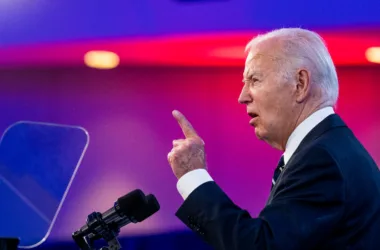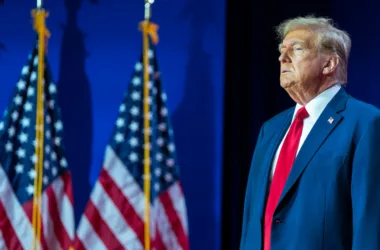NEW YORK — From auto manufacturing traces to Hollywood, the ability of labor unions is again within the nationwide highlight.
However regardless of historic strikes and report contract negotiations this 12 months, there’s quite a bit stacked in opposition to labor organizers at this time. Union membership charges have been falling for many years resulting from modifications within the U.S. financial system, employer opposition, rising political partisanship and authorized challenges.
“Regardless that we’re seeing stronger assist for unions, (with) the best reputation of union favorability in polls since no less than Sixties, translating the employee want for illustration into precise illustration is absolutely arduous beneath our present system,” Alexander Colvin, dean of Cornell College’s Faculty of Industrial and Labor Relations, instructed The Related Press.
Not less than 457,000 staff have participated in 315 strikes within the U.S. simply this 12 months, in accordance with Johnnie Kallas, a Ph.D. candidate and the challenge director of Cornell College’s Labor Motion Tracker.
The strikes have led to greater than 7.4 million days of missed work in 2023, S&P World Market Intelligence mentioned, the best stage in virtually 1 / 4 century.
Labor activism is reaching a boiling level amid hovering prices of dwelling and rising inequality, significantly the rising pay hole between staff and high executives. These inequities solely turned extra obtrusive in the course of the COVID-19 pandemic as U.S. firms raked in report earnings.
“It’s type of an ideal storm, (so) you see lots of union motion as of late,” mentioned Eunice Han, an assistant professor on the College of Utah specializing in labor economics.
The tightest U.S. labor market in a long time is including to leverage staff really feel they need to problem their employers.
The unemployment fee within the U.S. is near 50-year lows and there are actually about 1.5 open jobs for each unemployed individual, in accordance with current authorities knowledge.
In August, American employers posted a surprising 9.6 million job openings, far exceeding the expectations of economists out and in of the U.S. Federal Reserve, which as been trying to chill the labor market with a string of rate of interest hikes.
Open jobs means American staff are quitting in greater numbers as a result of they’re assured of touchdown a greater paying job.
The unemployment fee in September and August was 3.8%, additional signaling leverage for staff.
Whereas pickets traces appear to be in every single place, union membership charges have been declining for many years. Solely 6% of personal U.S. sector staff belong to unions at this time, a sliver of the 35% that have been union members in 1953.
Todd Vachon, an assistant professor within the Rutgers Faculty of Administration and Labor Relations, factors to the post-World Conflict II Taft-Hartley Act, which restricted the ability of labor unions – in addition to components like relocating manufacturing jobs abroad and an uptick in anti-union stances from each employers and lawmakers that grew within the 70s and 80s.
Vachon notes one pivotal second particularly, when President Ronald Reagan fired all putting air visitors controllers in 1981.
“That despatched a very clear sign to the enterprise group that it’s a-okay to be fully anti-union and to be so in a really belligerent manner, as a result of even the president of the USA is doing it,” he mentioned.
Individually, with the rise of the gig financial system, some giant firms have recategorized workers as “contractors,” making it tougher for them to unionize. And development in sectors that haven’t had a powerful historical past of union membership, equivalent to know-how, has additionally contributed to the decline in unionization.
Final 12 months, the variety of each private and non-private sector staff belonging to unions really grew by 273,000, in accordance with knowledge from the Bureau of Labor Statistics. However the U.S. workforce grew at a fair sooner fee, which means the share of these belonging to unions fell barely.
The Nationwide Labor Relations Act of 1935 granted non-public sector workers the proper to unionize, however authorized backing for public staff got here a long time later and even that varies by state.
A 1961 govt order from President John F. Kennedy allowed federal workers to prepare. That got here across the identical period that states additionally started to move labor legal guidelines for their very own public staff.
Typically, states within the Northeast, higher Midwest and West Coast adopted extra expansive collective bargaining legal guidelines – reaching all totally different classes of public workers, Vachon explains.
Some states within the South and decrease Midwest “will enable police and firefighters to collectively discount, however not state workers. Or they’ll let state workers discount, however they’ll solely discount over wages,” Vachon mentioned. “That reveals you the way essential the labor regulation is. It actually units the framework for which staff can both set up a union efficiently or not.”
A handful of states even have “proper to work” legal guidelines which, in unionized workplaces, require unions to characterize everybody no matter whether or not people select to pay dues or formally be part of. Such laws has been criticized for undermining the monetary sources and bargaining energy of unions.
Attitudes in direction of unionization have develop into more and more partisan, too, and likewise divided geographically. Politically “blue” states are likely to have greater unionization charges than “pink” states. A number of states have additionally dialed again on union protections in recent times, Han mentioned.
Unionization efforts have expanded however many are going down the place there may be little historical past of organized labor, creating the next bar for staff.
Colvin factors to Starbucks staff who’ve seen union drives clipped within the final 12 months. Starbucks has been accused of chilling group by closing unionized shops and firing pro-union staff. There are limits for organizers beneath present labor regulation.
“We now have a labor regulation that was designed within the period within the 30s and 40s, when auto vegetation of 10,000 staff (have been organizing),” he mentioned. Starbucks is “break up into these small espresso retailers of 15 staff… They should be part of collectively to have any type of bargaining energy in opposition to an enormous employer. However our labor regulation isn’t structured to assist them do this,” Colvin mentioned.
Service jobs could be arduous to prepare resulting from part-time work and excessive turnover charges. The identical could be mentioned for Amazon warehouses, the place there have been pushes for unions.
Nonetheless, extra staff in quite a few industries have begun organizing in recent times. And, significantly with high-profile strikes and contract negotiations seen this summer season, there’s a reinvigorated highlight on labor.
In accordance with Gallup public approval of stronger unions stood stood at 67%, down barely from the 71% approval seen final 12 months, however mirroring ranges final seen within the Sixties.
However the want to prepare can solely go to this point with out coverage change, specialists say.
“We’re completely at a turning level in folks’s consciousness,” Vachon provides. “Whether or not that interprets into precise a change of course for union density, I feel, goes to rely quite a bit on how that consciousness performs out within the political area.”









